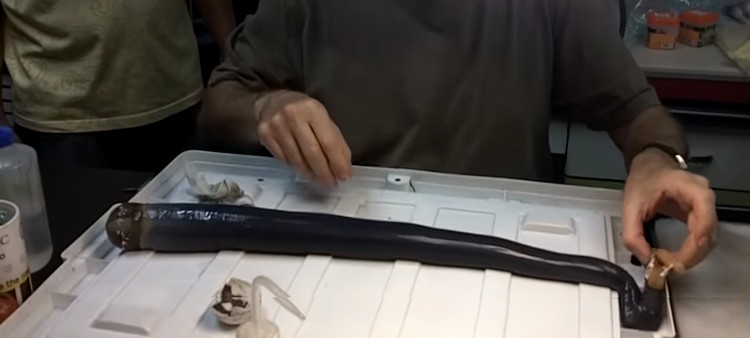The 1.5 meter long giant species makes scientists frightened
When the black haze drifted away from the ivory-hard crust, the researchers inevitably feared seeing its huge size.
Scientists have discovered a new species of up to 1.5 meters long, residing in an ivory-like shell. The giant species lives in mud gorges in the Philippines and relies on bacteria on gills to create food, according to National Geographic.
The study published yesterday on the Proceedings of the National Academy of Sciences (PNAS) reveals animals synthesizing energy from a sulfur in the mud. While the existence of the crust has been recorded since the 18th century, researchers have never approached animals that live in shells . The habitat of animals has never been known until a research collaborator shared a documentary broadcast on television about the species that lived under the mud in a shallow lagoon.

The giant species of Kuphus polythalamia.
The research team organized an expedition to find a living specimen of a giant species called Kuphus polythalamia . When the researchers found a Kuphus galaxy living in the crust, they followed Dr. Daniel Distel, the team leader and professor at Northeastern University, to open the crust and slash the bird.
"I was terrified when I first saw the massive body of this strange animal," said Marvin Altamia, a researcher at the Philippine University's Marine Science Institute.
Because animals have never been studied, scientists know very little about their survival history, habitat or biological characteristics . "We think giant galaxies are different from other wood-eating species. Finding animals allows us to confirm that. Indeed, I am very worried. If we make mistakes, we can lost the opportunity to discover the secrets of this extremely special specimen, " Altamia said.
The team explores why Kuphus is so different. Huge species of galaxies are found in a lagoon with many wooden items. While common species of perforated trees cut holes in trees that are washed away into the sea and eat wood with the aid of bacteria, Kuphus lives in mud and also uses bacteria to make food from mud instead of wood.
Mud in Kuphus's habitat releases hydrogen sulfide, a gas that smells of rotten eggs. Bacteria that live in the greens use hydrogen sulfide as an energy source to produce organic carbon, a process similar to how trees use solar energy to convert carbon in the air into food. Because Kuphus does not need to digest food, its digestive organs shrink due to lack of food.
One hypothesis about the origin of the giant haem by Dr. Distel is that a wood-eating species changes into a sulfur-dependent species by obtaining another beneficial bacterium.
The team will continue to examine the role of wood in the unique transformation between ordinary and giant galaxies.
- A half-meter-long corpse made the British confused
- Display giant ink
- The species that makes Australia the world's most feared place
- Giant momentum makes the scientific world confused
- Clash of giant termite species
- Ability to exist a 200 meter high ice wall under physical view
- Earth used to have a 10-meter-long worm
- A half-meter mouse may bite the coconut shell
- Mysterious UFOs on school grounds frightened the whole class in Wales
- A giant 5 meter long python chased after terrifying visitors
- A meter-long mouse in the US can threaten cats
- Detection of giant poisonous snakes in Kenya
 Animal 'suffering' after hibernation
Animal 'suffering' after hibernation Why do goats climb well?
Why do goats climb well? Scientists were surprised to see chimpanzees eating turtles
Scientists were surprised to see chimpanzees eating turtles Giant catfish died deadly due to drought in Thailand
Giant catfish died deadly due to drought in Thailand Four new species appear as 'hybrids' of extraterrestrial creatures
Four new species appear as 'hybrids' of extraterrestrial creatures  Strange species in Southeast Asia becomes the first marine fish species 'extinct due to humans'
Strange species in Southeast Asia becomes the first marine fish species 'extinct due to humans'  Ancient humans may still live on Indonesia's Flores island
Ancient humans may still live on Indonesia's Flores island  The 'dragon' species that was thought to only exist in myths is one of the rarest on the planet.
The 'dragon' species that was thought to only exist in myths is one of the rarest on the planet.  How many animals have ever existed on Earth?
How many animals have ever existed on Earth?  Treasure of Southeast Asia: Rare animal species found in only 9 countries in the world, Vietnam just received good news!
Treasure of Southeast Asia: Rare animal species found in only 9 countries in the world, Vietnam just received good news! 